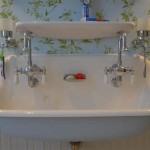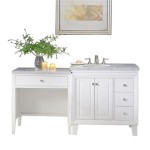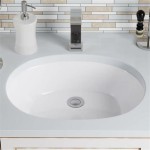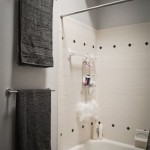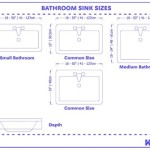Retro Bathroom Sinks: A Timeless Charm
Retro bathroom sinks are experiencing a resurgence in popularity, appealing to homeowners and designers seeking to infuse their bathrooms with character and a touch of nostalgia. These sinks, often characterized by unique shapes, vibrant colors, and durable materials, transport one back to distinct eras, from the sleek lines of mid-century modern to the ornate details of the Art Deco period. Understanding the different styles, materials, and considerations involved in selecting a retro bathroom sink is crucial for achieving the desired aesthetic and functionality.
The term "retro" encompasses a broad range of styles, making it essential to define the specific era or aesthetic that resonates most. For some, retro might evoke the playful colors and rounded forms of the 1950s. Others might be drawn to the clean, geometric designs of the 1960s and 1970s. Still others may prefer the opulent glamour of the 1920s and 1930s. Identifying this preference upfront will significantly narrow down the options and guide the selection process. The availability of vintage sinks, reproductions, and retro-inspired designs further complicates the matter, requiring careful consideration of authenticity, condition, and budget.
The appeal of retro bathroom sinks extends beyond mere aesthetics. They represent a departure from the often sterile and homogenous designs of contemporary bathrooms. Incorporating a retro sink can transform a mundane space into a statement of personal style and a conversation starter. Moreover, many vintage sinks were crafted using materials and techniques that prioritized durability and longevity, offering a welcome alternative to the mass-produced, often less robust, options available today.
Key Characteristics of Retro Bathroom Sink Styles
Several distinct design periods heavily influence the look and feel of retro bathroom sinks. Understanding these styles helps in identifying authentic pieces or choosing accurate reproductions. Each era offers unique silhouettes, colors, and material preferences that define its aesthetic. The following are some of the most prominent retro bathroom sink styles:
Mid-Century Modern (1940s-1960s): This style is characterized by clean lines, geometric shapes, and a focus on functionality. Sinks from this era often feature simple, minimalist designs with tapered legs or floating vanities. Colors were often pastel, such as mint green, baby blue, or pale pink, or contrasting colors like black and white. Fixtures were typically made of enameled cast iron or vitreous china.
Art Deco (1920s-1930s): Art Deco sinks are known for their geometric patterns, luxurious materials, and opulent details. Common features include stepped designs, chrome accents, and intricate carvings. Colors were often bold and glamorous, such as gold, black, and deep jewel tones. Materials frequently included marble, porcelain, and chrome.
Victorian (1837-1901): Victorian-era sinks often featured elaborate designs, ornate details, and a focus on craftsmanship. Common features include pedestal sinks with intricate legs, clawfoot tubs, and high-spout faucets. Materials used were typically porcelain, cast iron, and ceramic, with a strong emphasis on visual appeal and intricate details.
1950s Retro: Characterized by playful designs, pastel colors, and rounded forms, 1950s retro sinks often introduced elements of fun and informality into the bathroom. These sinks typically featured integrated countertops and cabinets, with bold color choices being a defining feature. Materials included laminate countertops, chrome accents, and enameled steel.
Identifying the overarching design style helps pinpoint the specific features and characteristics that should be present in an authentic or well-designed retro sink. This ultimately contributes to creating a cohesive and aesthetically pleasing bathroom design.
Material Considerations for Retro Bathroom Sinks
The material used in a retro bathroom sink significantly impacts its appearance, durability, and maintenance requirements. Understanding the properties of different materials is crucial for making an informed decision that aligns with both aesthetic preferences and practical needs. The following materials are commonly found in retro bathroom sinks:
Vitreous China: This is a popular choice for its durability, resistance to staining, and ease of cleaning. Vitreous china is a type of ceramic that has been fired at high temperatures to create a non-porous surface. It is available in a wide range of colors and styles, making it a versatile option for retro bathroom designs. Vitreous china is less prone to chipping and scratching compared to other materials, contributing to its longevity.
Enameled Cast Iron: Cast iron sinks are known for their exceptional durability and heat retention. They are coated with a layer of enamel to provide a smooth, glossy finish. Enameled cast iron sinks are resistant to scratching and chipping, but they can be heavy and require a sturdy base for support. They are available in a variety of colors and styles, making them suitable for different retro bathroom designs. However, if the enamel coating is damaged, the underlying cast iron can rust, requiring prompt repair.
Porcelain: Porcelain sinks are similar to vitreous china but are often more delicate and prone to chipping. Porcelain is a type of ceramic made from fine clay and fired at high temperatures. While porcelain offers a smooth, glossy finish and can be molded into intricate shapes, it is less durable than vitreous china and requires careful handling. Porcelain sinks are often found in vintage bathrooms and can add a touch of elegance to a retro design.
Fireclay: Fireclay sinks are made from a blend of clay and minerals that are fired at extremely high temperatures. This process creates a dense, durable material that is resistant to staining, scratching, and cracking. Fireclay sinks are often used in farmhouse-style bathrooms and can add a rustic touch to a retro design. They are available in a variety of colors and sizes, making them a versatile option for different bathroom layouts.
Other Materials: While less common, other materials like stainless steel, copper, and even glass can be found in retro-inspired bathroom sinks. These materials offer unique aesthetic qualities but may require more specialized care and maintenance. Stainless steel offers a sleek, industrial look, while copper adds warmth and richness. Glass sinks, although visually striking, can be fragile and require careful handling.
The choice of material ultimately depends on the desired aesthetic, budget, and practical considerations. Balancing these factors ensures the selection of a retro bathroom sink that is both visually appealing and durable.
Integrating Retro Sinks into Modern Bathrooms
Incorporating a retro bathroom sink into a modern bathroom requires careful planning to ensure a cohesive and balanced design. The key is to create a harmonious blend of old and new, rather than simply juxtaposing contrasting styles. This can be achieved by considering the following factors:
Color Palette: The color palette plays a crucial role in creating a cohesive retro-modern bathroom. Selecting colors that complement both the retro sink and the modern elements is essential. For example, a pastel-colored retro sink can be paired with neutral walls and modern fixtures in chrome or brushed nickel. Alternatively, a bold, brightly colored sink can be balanced with more subdued colors elsewhere in the bathroom. Contrast is important, but it should be carefully managed to avoid visual clashes.
Fixture Selection: The choice of faucets, showerheads, and other fixtures can either enhance or detract from the overall retro aesthetic. Opting for fixtures with a vintage-inspired design, such as bridge faucets or cross-handle faucets, can complement the retro sink and add to the overall charm. However, it is important to ensure that these fixtures are also functional and meet modern plumbing standards. Mixing vintage fixtures with contemporary elements can create a unique and personalized look.
Accessorizing: Accessories offer an opportunity to further enhance the retro theme. Vintage-inspired mirrors, soap dishes, and towel racks can add to the overall ambiance. However, it is important to avoid cluttering the space with too many accessories. A few well-chosen pieces can make a significant impact without overwhelming the design. Additionally, consider incorporating modern amenities, such as heated towel racks or smart mirrors, to blend comfort and convenience with a retro aesthetic.
Space Planning: Carefully consider the layout of the bathroom to ensure that the retro sink is integrated seamlessly into the overall design. Ensure that there is adequate space around the sink for comfortable use. Pay attention to the placement of other fixtures and furniture to create a balanced and functional layout. In smaller bathrooms, consider using a pedestal sink to save space. In larger bathrooms, a vanity with ample storage can provide both functionality and visual appeal.
Lighting: Lighting plays a critical role in highlighting the retro design elements. Incorporating vintage-inspired lighting fixtures, such as sconces or pendant lights, can enhance the retro aesthetic. However, it is equally important to ensure that the lighting is functional and provides adequate illumination for tasks such as grooming and makeup application. Mixing vintage and modern lighting fixtures can create a unique and personalized look.
By carefully considering these factors, it is possible to seamlessly integrate a retro bathroom sink into a modern bathroom, creating a space that is both stylish and functional. The key is to strike a balance between old and new, creating a cohesive design that reflects personal style and appreciation for retro aesthetics.

Retro 1045 1070 Ws Bath Collections

Vintage Bathroom Sink Design Ideas

24 Cast Iron High Back Farm Sink Vintage Tub Bath

Retro 1047 1070 By Ws Bath Collections Vintage Ceramic Pedestal Bathroom Sink In Glossy White 28 7 Modo

Vintage Bathroom Sinks House Crazy Sarah

Retro 1045 Ws Bath Collections

Wide Variety Of High Quality Bathroom Sinks Vintage Tub Bath

Vintage Wall Mount Bathroom Double Sink Love The Blue Under Belly

How To Get A Victorian Sink For Your Bathroom Ideas

Where To Find A Vintage Bathroom Sink With Chrome Legs And Towel Bars Retro Renovation
Related Posts
